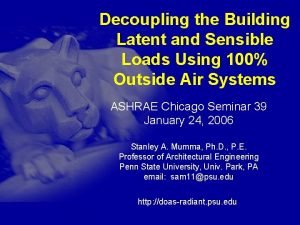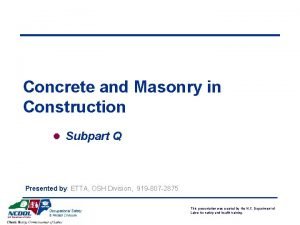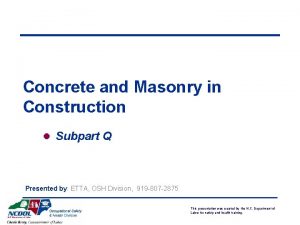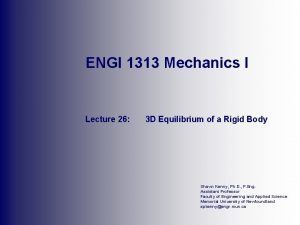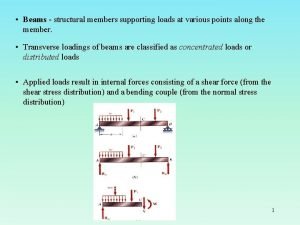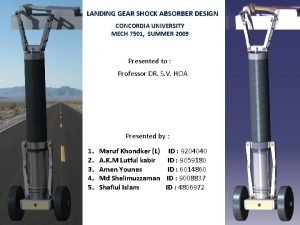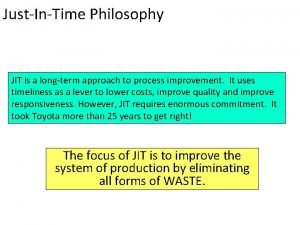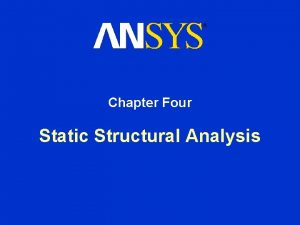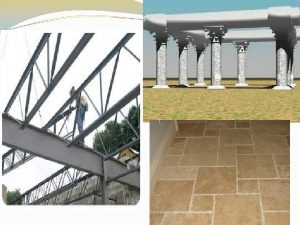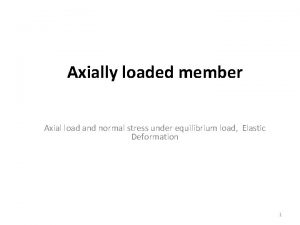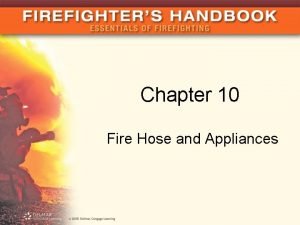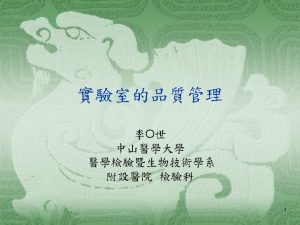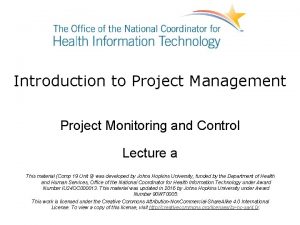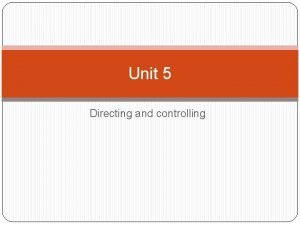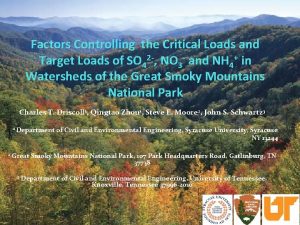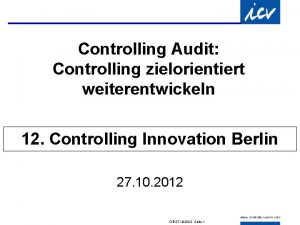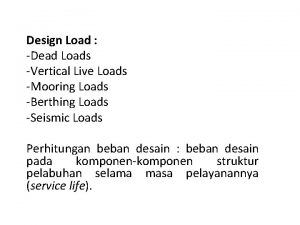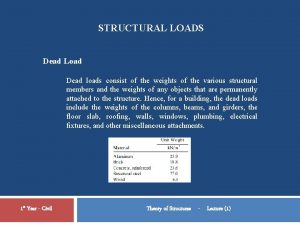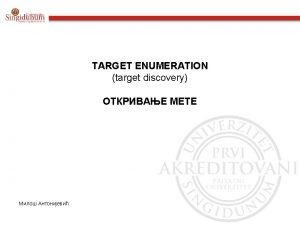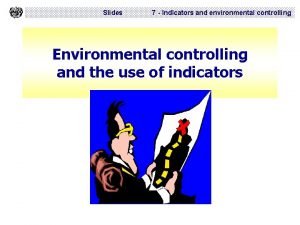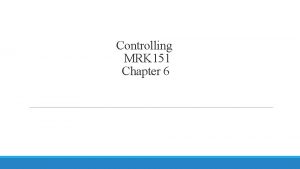Factors Controlling the Critical Loads and Target Loads



















































- Slides: 51

Factors Controlling the Critical Loads and Target Loads of SO 42 -, NO 3 - and NH 4+ in Watersheds of the Great Smoky Mountains National Park Charles T. Driscoll 1, Qingtao Zhou 1, Jason Lynch 2, Steve E. Moore 3, John S. Schwartz 4 1 Department of Civil and Environmental Engineering, Syracuse University, Syracuse NY 13244 2 Clean Markets Division, U. S. Environmental Protection Agency, Washington, DC 20460 3 Great Smoky Mountains National Park, 107 Park Headquarters Road, Gatlinburg, TN 37738 4 Department of Civil and Environmental Engineering, University of Tennessee, Knoxville, Tennessee 37996 -2010

2 Outline �Background �Objectives �Approach �Results �Examples of model simulations for GRSM watersheds �Analysis of historical acidification and recovery �Park-wide extrapolation �Conclusions

Stream Chemistry Results and Trends 303 d Listing • In 2006, 12 streams representing 42 miles (67 km) were listed on the Tennessee 303 d list due to low stream p. H (<6. 0) • Identified & listed only streams outside of Anakeesta influence • 3 impaired streams modeled Inadu Creek Otter Creek Rock Creek Copperhead Branch Buck Fork Cannon Creek Lowes Creek Road Prong Goshen Prong Unnamed trib Eagle Rocks Prong Shutts Prong 3

4 p. H and ANC Targets �TMDL target p. H = 6. 0 �p. H is a challenge to measure (field vs. lab) �Measurement sensitive to temperature and CO 2 �Acid neutralizing capacity (ANC) is a more robust indicator of the acid-base status of waters. �Ability of a water to neutralize strong acid �Titration by strong acid (ANCG) �ANCcalc = base cations – strong acid anions �ANCcalc = CB - CA

5 p. H vs ANC for Goshen Prong

Site-Specific Target ANC Values Based on Regression Analysis Monitoring Site Description Target ANC (µeq/L) 4 Lower Rock Creek 35 137 Upper Rock Creek 15 138 Inadu Creek 10 103 Otter Creek 10 104 Copperhead Branch 25 45 Shutts Prong 15 47 Lower Cannon Creek 19 71 Lower Road Prong 25 234 Upper Road Prong 20 213 Goshen Prong 18 218 UT to Fish Camp Prong 20 Eagles Rock Prong 6 6

7

8

9 Objectives �To assess the response of streams and soils in the GRSM to past and potential future changes in the acidic deposition. �To establish the Target Loads (TL) and Critical Loads(CL) for N and S deposition for watersheds of the GRSM. �To explore the factors that control the critical loads in the GRSM. �To compare results of simulations for GRSM watersheds to past and potential future changes in atmospheric deposition with Pn. ET-BGC and MAGIC. �Inform the process to develop a Total Maximum Daily Load (TMDL) for acidity for the GRSM and elsewhere.

10 10 Approach Wet Deposition Dry Deposition Pn. ET Water balance Photosynthesis Living biomass Litterfall Net Mineralization Climatic Data • Solar radiation • Precipitation • Temperature Atmospheric Chemistry Carbon dioxide Uptake a Sh Ozone w llo BGC • Aqueous reactions • Surface reactions • Cation exchange • Adsorption • Humic binding • Aluminum dissolution/precipitation Weathering w lo rf e at w BGC – Surface water Aqueous reactions Deep water flow

11 p. H Dependent Sulfate Adsorption M OH + SO 42 - Decreases in p. H protonate soil surfaces and enhance SO 42 adsorption H M M O O + H 2+ SO 4 H + H M M O O H + H SO 42 -

12 Data Sets Used to Apply Pn. ET-BGC Meteorological data • Air temperature (max & min) (°C) • Precipitation (cm) • Solar radiation (mmol/m 2 -s) Deposition data • Wet deposition • CASTNet (Dry to wet ratio) • Throughfall (Dry to wet ratio) Vegetation data • Vegetation type • Disturbance history Soils data • Exchangeable cations • Adsorbed sulfate • Soil properties (soil, mass, WHC, CEC)

13 Pn. ET-BGC Model Outputs Surface water • Discharge • chemistry (SO 42 -, NO 3 -, NH 4+, DOC, Ca, Al…) • Solute fluxes Soil • Concentrations (SOC, N, Ca, Al…) • Soil pools • Soil transfers (cation exchange, anion adsorption, mineralization, nitrification, plant uptake…) Vegetation • Biomass (foliage, wood, roots, NPP, NEP) • Vegetation pools (C, N, Ca…) • Vegetation transfers (litter fall, nutrient uptake, foliar leaching…)

14

Biophysical and Chemical Characteristics of Different Watersheds 15 Elevation m (ft) Watershed areas km 2 (ac) Disturbance Noland Divide 1798 (5899) 0. 174 (43) Balsam Wooly Adelgid SF 44. 3 Indian Camp Creek 1205 (3953) 6. 31 (1559) Land disturbance HD 42. 1 16. 9 Walker Camp 1168 (3832) 4. 24 (1048) None HD 38 -13. 3 Goshen Prong 1046 (3432) 7. 29 (1801) Logging HD 21. 2 19. 3 Lost Bottom 1000 (3281) 5. 15 (1273) Land disturbance HD 7. 7 59. 2 Left Prong Anthony 909 (2982) 1. 61 (398) None SF 23. 4 35. 4 Pretty Hollow 903 (2963) 11. 18 (2763) Land disturbance HD 16. 6 46. 1 Cosby Creek 783 (2569) 5. 78 (1428) Land disturbance HD 38. 2 36. 8 Sugar Fork 780 (2559) 2. 14 (529) Land disturbance HD 3. 7 86. 3 Cannon Creek 751 (2464) 4. 19 (1035) Land disturbance HD 20. 6 17. 1 Thunderhead 664 (2178) 11. 26 (2782) Fire HD 14. 4 33. 2 Mill Creek 545 (1788) 10. 92 (2698) Land disturbance HD 56. 1 17 Vegetation NO 3 - (µeq/L) ANC (µeq/L)

Approach: The Criterion of Choosing Different Sites in GRSM Study sites in block units Block Basin Area km 2 (ac) Elevation m (ft) Anakeesta 1 <10 (<2471) <1000 (3281) >10% 2 <10 (<2471) >1000 (3281) >10% 3 <10 (<2471) <1000 (3281) None 4 <10 (<2471) >1000 (3281) None 5 10 -20 (2471 -4942) <1000 (3281) >10% 6 10 -20 (2471 -4942) >1000 (3281) >10% 7 10 -20 (2471 -4942) <1000 (3281) None 8 10 -20 (2471 -4942) >1000 (3281) None 16

Watershed Block Design for Monitoring • Stratified GRSM watersheds into block design based upon: watershed size (<10 km 2 or 10 -20 km 2), elevation (> or < 1, 000 m) and percent Anakeesta (0% or >10%) • Block design captured nearly 80% of watersheds (remainder <1 or>20 km 2) 17

18

Soil Chemistry Data: National Cooperative Soil Survey: National Cooperative Soil Characterization Database �Soil Data Sources – 1) DDRP 2) Grell Thesis 3) NCSCD �DDRP: Most comparable soil chemistry methods for use with MAGIC, but limited coverage within GRSM and sample date back to 1984 �Grell Thesis: Methods of soil chemistry not compatible with MAGIC �NCSCD: Best coverage of soil pit chemistry data, but soil chemistry methods need to be adjusted for use with MAGIC (NH 4(Ac) vs. NH 4 Cl) 19

20 Site Elevation (m) Area (km 2) Vegetation %Anakeesta Noland Divide 1798 0. 174 SF No Indian Camp Creek 1205 2. 17 HD No Walker Camp 1168 10. 73 HD 81. 89% Goshen Prong 1046 7. 29 HD 26. 83% Lost Bottom 1000 5. 15 HD No Left Prong Anthony 909 1. 61 SF No Pretty Hollow 903 11. 18 HD No Cosby Creek 783 5. 78 HD No Sugar Fork 780 2. 14 HD No Cannon Creek 751 4. 19 HD 0. 64% Thunderhead 664 11. 26 HD 34. 73% Mill Creek 545 10. 92 HD No Length ANC Impaired of record (μeq/L) 19912008 19932003 19942009 19942003 19932009 19962009 19942003 19962009 24. 8 17. 82 -13. 85 20. 78 303 d 50. 34 34. 85 47. 03 37. 33 90. 32 16. 25 33. 22 46. 08 303 d

Testing and Evaluation of Model Performance Comparison with measured values • • Discharge Stream chemistry Soil chemistry Ecosystem biogeochemical measurements Performance statistical metrics • Normalized Mean Error (NME) • Normalized Mean Absolute Error (NMAE) Sensitivity/uncertainty analysis Comparison with other models • Comparison with MAGIC 21

22 Results: Model Performance • No significant differences between measured to simulated (modeled) results

23 Results

24

Model Predicted Element Fluxes (1993 -2008) 25 NH 4 -N (kg/ha-yr) NO 3 -N (kg/ha-yr) SO 4 -S (kg/ha-yr) Ca (kg/ha-yr) Deposition 4. 08 14. 3 29. 1 1. 31 Weathering 0 0 1. 2 5. 4 Mineralization 33. 3 0 13. 1 34. 0 Nitrification -23. 6 0 0 Plant Uptake -12. 8 -31. 8 -13. 5 -48. 8 0 -19. 8 12. 5 -7. 6 -10. 3 -18. 5 Sorption Drainage losses 0 Note: Positive=Input; Negative=Output

Comparison of Modeled and Measured Fluxes NH 4 -N (kg/ha-yr) Throughfall Deposition IFS UTM 0. 28 4. 2 Weathering 26 NO 3 -N (kg/ha-yr) Model IFS 4. 08 16. 8 0 0 UTM 12. 5 Model 14. 3 0 Mineralization 33. 3 0 Nitrification -23. 6 Plant Uptake -12. 8 -26. 4 -31. 8 Sorption Drainage losses 0 0. 3 0 -9. 92 -7. 6

Comparison of Modeled and Measured Fluxes SO 4 -S (kg/ha-yr) 27 Ca kg/ha-yr) IFS UTM Model IFS 40 32 29. 1 18. 76 Weathering 1. 2 5. 4 Mineralization 13. 1 34. 0 0 0 Throughfall Deposition Nitrification Plant Uptake -3. 5 -13. 5 Sorption Drainage losses UTM 18. 0 -10. 3 17. 6 5. 4 -8. 65 -48. 8 -19. 8 -10. 24 Model 12. 5 -16. 54 -18. 5

28

29

30

31

32

33

34

35

36

37

38

39

Differential ANC Response to Sulfate vs. Nitrate Deposition DCL 2050 0. 00058 0. 22 CL 2200 0. 0041 0. 52 40

41 Results

42 Historical Acidification

43 Recovery

44 site Current ANC (µeq/L) ANC in 1850 (µeq/L) Current Deposition (meq/m 2 -yr) Target ANC Sulfate + Nitrate Deposition (meq/m 2 -yr) Sulfate + Nitrate Deposition (meq/m 2 - yr) ANC=0 (µeq/L) ANC = 20 (µeq/L) ANC =50 (µeq/L) Noland Divide 4. 3 27. 4 201 91 0 0 Goshen Prong 19. 3 58. 9 197 76 0 0 Cosby Creek 36. 9 93. 1 165 370 130 0 Lost Bottom Creek 59. 2 89. 8 103 600 390 80

45

Extrapolation of Future Deposition Projections Park-Wide �Utilize empirical relationships from model results from 12 watershed study sites �Utilize stream survey data for the GRSM 46

47 Conclusions �Pn. ET-BGC is able to simulate current stream chemistry at the GRSM. �Hindcast simulations suggest that historical atmospheric deposition has resulted in marked increases in stream SO 42 - (25 µeq/L) and NO 3 - (22 µeq/L), resulting in decreases in the p. H (-0. 6) and ANC (– 37 µeq/L). �The stream ANC in the GRSM increases to a greater extent in response to decreases in NO 3 - deposition than to decreases in SO 42 - or NH 4+. �Decreases in NO 3 - deposition to GRSM watersheds cause desorption of previously absorbed soil SO 42 -, which delays recovery.

48 Conclusions �There is a relationship between historical acidification and potential watershed recovery with changes in NO 3 - plus SO 42 - deposition and historical ANC (1850). �A relationship exists between current ANC and the level of deposition needed to achieve a target ANC. This relationship could be utilized with stream survey data for the GRSM to develop a Park-wide TMDL.

49 Future Activities �Continue comparison of results with MAGIC. �Extrapolation of model result to entire Park. �Project communication activities. �Complete project report.

50 Questions?

51
 Critical semi critical and non critical instruments
Critical semi critical and non critical instruments Spaulding classification system
Spaulding classification system Primary target market and secondary target market
Primary target market and secondary target market Compare non-critical readers with critical readers.
Compare non-critical readers with critical readers. Abiotic or biotic
Abiotic or biotic Abiotic vs biotic factors
Abiotic vs biotic factors Aboitic environment
Aboitic environment All the factors of 48
All the factors of 48 Common factors of 10 and 20
Common factors of 10 and 20 Factors of 8 and 24
Factors of 8 and 24 Critical factors for new venture development
Critical factors for new venture development Chapter 6 feasibility study
Chapter 6 feasibility study Sensible loads in radiant cooling
Sensible loads in radiant cooling Positive fail safe joint connectors
Positive fail safe joint connectors Protruding reinforced steel must be guarded
Protruding reinforced steel must be guarded Flat load fire hose
Flat load fire hose Mechanical load on human body
Mechanical load on human body The pipe assembly supports the vertical loads shown
The pipe assembly supports the vertical loads shown The structural members supporting loads at various points.
The structural members supporting loads at various points. Archimedes principle
Archimedes principle A limited access zone must
A limited access zone must Shock absorber design
Shock absorber design Just in time philosophy
Just in time philosophy Static structural analysis
Static structural analysis Members used to carry wall loads over wall openings
Members used to carry wall loads over wall openings Design against fluctuating load
Design against fluctuating load Approximate method of structural analysis
Approximate method of structural analysis Elastic deformation of an axially loaded member
Elastic deformation of an axially loaded member Racking stress of container
Racking stress of container Principle of material handling
Principle of material handling Types of hose folding
Types of hose folding Planning organizing staffing leading and controlling
Planning organizing staffing leading and controlling Function of management
Function of management Control idea
Control idea Manager is someone who
Manager is someone who Demand characteristics
Demand characteristics Topic controlling idea
Topic controlling idea Staffing and controlling
Staffing and controlling Directing function of management
Directing function of management Planning organizing leading controlling
Planning organizing leading controlling For me the worst thing about waiting tables is the uniform
For me the worst thing about waiting tables is the uniform Monitor and control project work
Monitor and control project work Directing and controlling
Directing and controlling Starbucks planning organizing leading and controlling
Starbucks planning organizing leading and controlling Site versus situation
Site versus situation Biotic vs abiotic factors
Biotic vs abiotic factors Losch zone of profitability
Losch zone of profitability Hình ảnh bộ gõ cơ thể búng tay
Hình ảnh bộ gõ cơ thể búng tay Frameset trong html5
Frameset trong html5 Bổ thể
Bổ thể Tỉ lệ cơ thể trẻ em
Tỉ lệ cơ thể trẻ em Chó sói
Chó sói












